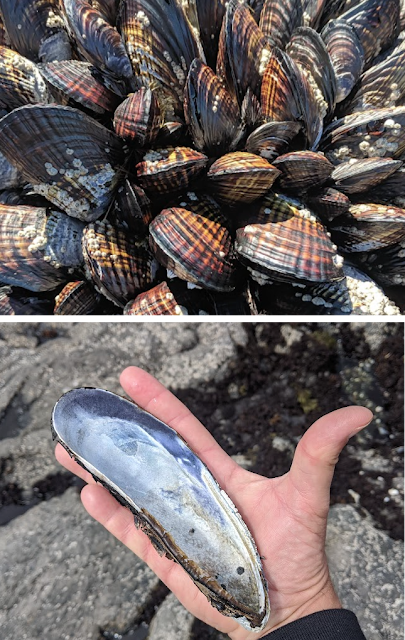Now we know a couple of things...
 |
| California mussel (Mytilus californianus) |
The fake fish lure is pretty amazing:
 |
| Not a fish, but the exterior part of a mussel that looks and moves just like a tiny shiner fish. |
As someone pointed out, that's a pretty amazing bit of mimicry for an animal that can't see--but of course, the ability to see doesn't matter in an evolutionary context. It's not like the eyes are connected to the mantle tissue that extends outside of its shell, so whether or not it can see isn't material to the mimicry.
2. In addition to a fake fish lure, there are OTHER mimic devices that freshwater mussels use. Can you find them as well? (Think beyond a minnow sitting on top of the mussel shell.)
Now that I know that "mimicry" is the preferred term of art, my next query was:
[ mussel mimicry -Lampsilis ]
Why the -Lampsilis in the query? Because I wanted to find OTHER mechanisms than what Lampsilis would use. I already know that they use a fake fish lure--but what would other mussels do to attract fish to their glochidia?
Sure enough, the very first hit was to a National Wildlife Federation page about other kinds of mussel lures. Here I learned about snuffbox mussel and riffleshell mussel, both of which trap curious fish with a snap of their shells and while holding them tight, douse them with a cloud of tiny glochidia! That's pretty aggressive action by a otherwise quiet mussel! You can see the snuffbox mussel (Epioblasma triquetra) grabbing a logperch fish by the nose and holding on for a few seconds, blowing glochidia into its mouth and over the gills.
Here's a still frame from that video, the mussel holding the logperch quite firmly:
What's more, the edge of the mussel shell has denticles (little teeth-like serrations) that help it hold onto the fish snout. In this mussel, a part of the mantle inflates to form a gasket-like seal around the head of the captured fish, reducing the leakage of glochidia.
And one more video of mussel mimicry and fish capture behavior, just because it's so wonderful:
But wait.. there's more!
While reading, I was impressed when I read this sentence: "Many species of [mussels such as] Pleurobemini and some Lampsilini release conglutinates of eggs and larvae that resemble host food items."
That's a big tipoff: a conglutinate that resembles host food items? What's that?
My next query was:
[ mussel conglutinate mimicry ]
and I quickly learned that "the mantle lures and conglutinates of various mussel species can mimic fish, a wide variety of aquatic insects, crayfish, snails, leeches, worms, and other prey of their fish hosts.."
Looking at the Images tab shows us some of the various forms of the conglutinates (which I learned are bits of mucus-like stuff that stick together with glochidia. Again, through the power of evolution, these conglutinates look an awful lot like tasty fish food.
 |
| Thumbnails of different mussel conglutinates. Some look like worms, insect larvae, others like fish, while others like shrimp or packets of eggs. |
This is a closeup of the conglutinate in the lower left:
 |
| Looks like a watercolor painting, but is actually the conglutinate of Ptychobranchus subtentum, which strongly resembles pupae of the blackfly. |
Or, for a better image of the entire conglutinate mass, here's an image from the US Fish and Wildlife Service showing how they all stick together:
Once again, we see the importance of knowing the right terms. Last time we learned about "mimicry" as a technical term that will improve the accuracy of your searches. This time we found that removing Lampsilis as a term would let us see even more results. And we found "conglutinates" as just the right words to let us find even more amazing mimicry behavior.
For our third special-edition SRS Challenge of the week, we turn our attention to the point of all this fakery--the glochidia.
3. The point of all this mussel-bound fakery is to get the glochidia into the gills of fish. Are the glochidia actually parasites? Or are they just hitching a ride on the fish's gills?
Let us know what you find out.
Keep searching.


Hi Dr. Russell
ReplyDeleteIt's very interesting. Thanks for sharing.
While searching this past weekend, I read, I think, about Q3. I'm not sure if it was the glochidia, however, it was just the ride.
I'll re Search and confirm that is what you are looking for. Maybe it was a different kind of ride
With [glochidia fish gills]
ReplyDeleteFound the answer. Other asked questions are: Why do glochidia attach to fish gills?
Do glochidia feed on fish? They drink some fluids
About Glochidia
DeleteUB researchers study if freshwater mussels can clean Niagara River
https://www.buffalo.edu/ubnow/stories/2023/11/mussels-niagara-river.html
Glochidia photos
https://bsky.app/profile/ckrabb.bsky.social/post/3klzfsgahad2l
kinda spooky…
ReplyDelete(how does a "likeness" evolve without eyes? or some sort of reference to how the mimicked object appears to what is being baited? )
https://i.imgur.com/hdb8UXV.jpg
in the aquarium… mussel and friends
ReplyDeletehttps://i.imgur.com/JZkY294.jpg
Deleteshould address the error code
https://i.imgur.com/L8eX6Wa.jpg